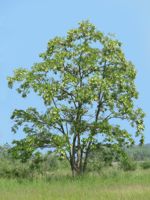Mon-Fri 9am - 5pm Mountain time
Black Locust vs Dahurian Birch
Robinia pseudoacacia
Betula davurica
CUSTOM GROW
Black Locust is an attractive tree. Its distinctive leaves are made of about a dozen bright green leaflets. It also notable for its fragrant white flowers, which smell of citrus.
Black Locust can grow in many situations, but prefers dry areas with lots of sun. It is robust and is an excellent choice for establishing shade in dry, open areas.
Important note: Much of the Black Locust is toxic to humans and livestock, including seeds, bark, and leaves.
Dahurian Birch is a rare and interesting ornamental with curling bark. This tree is the first to sprout on bare land and is tolerant of dry, gravelly, and infertile soils. Dahurian Birch can grow in industrial areas or exposed land as long as it has full sunlight.
This tree is ideal for landscaping, ornamental, and ecosystem services.
This tree is not well known, but is a favorite of nursery owners across the country.

